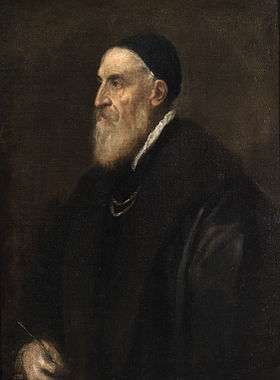Danaë (Titian series)


.jpg)
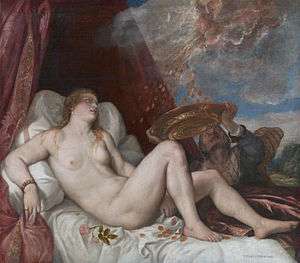
The Danaë (or Danaë and the Shower of Gold) series comprises at least five[2] oil-on-canvas paintings by the Venetian master Titian, completed between 1540 and 1570. The works are based on the mythological princess Danaë. According to Ovid she was isolated in a bronze dungeon following a prophecy that her firstborn would eventually kill her father.[3] Although aware of the consequences, Danaë was seduced and became pregnant by Zeus (in Roman mythology Jupiter), who, inflamed by lust, descended from Mount Olympus to entice her as a shower of gold.[4]
The first version, now in Naples, was painted between 1544-46. Titian executed a later version on commission from the art-loving Spanish monarch Philip II. Titian and his workshop produced at least five versions of the painting, which vary to degrees. The dog resting at Danaë's side is absent in some versions, while her companion is a god in some and a haggish nursemaid in others. In all, Danaë is depicted as a voluptuous figure. Her legs are open in all, with her left leg arched; this being a central painterly motif in each.[5]
The works have been highly influential and affected the work of many artists including Rembrandt,[6] Anthony van Dyck and Gustav Klimt, who all painted versions of the scene. According to the 16th-century Italian historian Giorgio Vasari, Michelangelo saw the original and praised Titian's use of colour in the Madrid painting, though later, in private, was critical of Titian's draftsmanship.[7]
Legend of Danaë
A version was commissioned by Philip II as part of a series of mythological paintings described by Titian as "poesie" ("poems").[8] According to Greek mythology known by Titian through Ovid's telling, when Acrisius consulted the oracle on how he would get male children, he was told that his daughter would bear a son who would kill him. Acrisius then locked up and guarded his daughter Danaë in a subterranean dungeon.[9] Danaë, aware of the consequences, allowed herself to be seduced and impregnated by Zeus, who persuaded her to lower her defenses by appearing in the form of a shower of gold.[10][11]
When Acrisius learned of Danaë's son Perseus, he refused to believe Zeus's role, and cast mother and child adrift at sea in a chest. They landed at Seriphus, where Perseus was raised by Dictys. Perseus eventually fulfilled the prophecy by killing Acrisius years after—although accidentally. There are a number of versions of Acrisius' death. In Pseudo-Apollodorus' version, when Perseus learns of the oracle he goes into voluntary exile in Pelasgiotis (Thessaly), where Teutamides, king of Larissa, is holding funeral games for his father. Perseus competes in the discus throw, but his missile veers and strikes Acrisius, killing him instantly.
Danaë was seen in the Middle Ages and Renaissance as a symbol of the corrupting effect of wealth, which could taint even feminine beauty or moral virtue.[6] An epigrammist in the Greek Anthology wrote of the legend of Danaë and Zeus:
Thou didst fall in a rain of gold on Danaë, Olympian Zeus, that the child yield to thee as to a gift...Zeus bought Danaë for gold...piercing the brazen chamber of Danaë, cut the knot of intact virginity. I think the meaning of the story is this "Gold the subduer of all things, gets the better of brazen walls and fetters, gold loosens all reins and opens every lock, gold makes the ladies with scornful eyes bend the knee. It was gold that bent the will of Danaë. No need to for a lover to pray to Aphrodite, if he brings money to offer.[11]
Series
In keeping with the Renaissance view of Danaë, Titian has depicted her with the fleshy body of a courtesan,[12] although she is given the facial features of a graceful contemporary Venetian lady.[13] The 1544–1546 version suggests her fall from grace in a number of ways, including the presence of thunderous clouds, her now-complete nakedness, and the dog (sometimes used as a symbol of libertinism) curling to her left. The old woman's body is now turned fully towards the rain of gold, whereas Eros had his back to the skyscape, with his head turned back.
In each work, Danaë is shown naked or nearly naked, lying on a couch with her knees raised. Either a nursemaid or Eros is to her right, holding out a cloth to catch the gold coins spilling down from an explosion of colour in the sky which represents Zeus.[14] The left side of each canvas is an interior. In the Madrid painting, this area is rendered in warm sensual colours of brown and pink framed by purple velvet drapes; the right side of the canvas contains cooler grey and blue tones.[13]

In the 1544–1546 version, the burst of light that showers coins and on which Danaë's heavy gaze falls is flanked by dark clouds that appear to be moving towards the centre of the canvas. They spill heavy rain, which falls parallel to Zeus's coins. In the Madrid version, Eros has been replaced by an old woman, whose ugliness draws attention by comparison to the beauty of Danaë.[15] The greenish cast of her skin is set against the pale hues of the younger woman. In the Madrid version a maidservant replaces Cupid. Danaë parts her lips in pleasure, while the gold spills in greater quantity and with more velocity than in the Naples work. That painting is rendered in a looser manner; for example the folds of the bed linen and pillow are described with shorter more expressive brushstrokes.[16]
While the series freely describes desirable flesh in an overtly sexual manner, Titian transforms the motifs of courtesans and carnal desire into the more highbrow realm of classical myth.
Influence
When Michelangelo and Giorgio Vasari visited Titian at his temporary studio in the Vatican Belvedere, they were shown a Danaë which was in the process of completion. While in the studio, Michelangelo highly praised Titian's use of colour, but later expressed reservations on his grasp of the "sound principles" of draughtsmanship and composition. James Northcote quotes Vasari's account of Michelangelo's words:
For I am conscious that if this man was as much assisted by art, as he is by nature, no mortal could go further. He has a noble spirit; but as of present having no knowledge of design, he in his imitations of the life corrects nothing nor attempts to make it better, though possessed of a manner so easy and beautiful, so full of truth and animation. But certain it is, that not having studied the best work of the ancients, the Venetians know not how to mend or how to give a grace and perfection to their works beyond their model, which is never perfect in all parts. The moderns in general cannot, from their own resources, be correct, but are obliged to make a literal copy of the object before their eyes, not knowing what it ought to be.[17]
Vasari's account needs to be treated within context; in his view draftsmanship — disegno — was the highest achievement in art, while colour was secondary. This belief may have led to his fabrication of the anecdote in order to give more weight to his views.[13]
- Influence


_Danae.jpg) Danae, Alexandre Jacques Chantron, 1891.
Danae, Alexandre Jacques Chantron, 1891. Gustav Klimt's Danaë, 1907. Klimt's debt to Titian is evident in the raised leg of the model
Gustav Klimt's Danaë, 1907. Klimt's debt to Titian is evident in the raised leg of the model
Mythological commissions
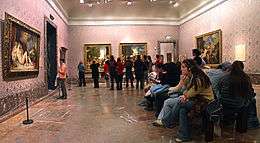
The Madrid version of Danaë is no longer thought to be part of the commission from Philip II for seven mythological paintings by Titian, but rather a later addition to the royal collection. It is displayed in the same room as Venus and Adonis from the original commission.
Other works in the mythological series
- Diana and Actaeon (owned jointly by London's National Gallery and the National Gallery of Scotland in Edinburgh)
- Diana and Callisto (owned jointly by London's National Gallery and the National Gallery of Scotland in Edinburgh)
- Perseus and Andromeda (Wallace Collection)
- The Rape of Europa (Isabella Stewart Gardner Museum)
- Venus and Adonis (Museo del Prado)
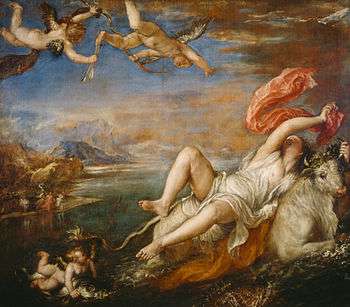
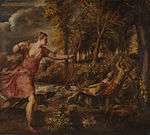 The Death of Actaeon
The Death of Actaeon Diana and Actaeon
Diana and Actaeon Venus and Adonis
Venus and Adonis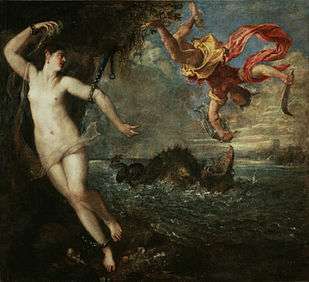 Perseus and Andromeda
Perseus and Andromeda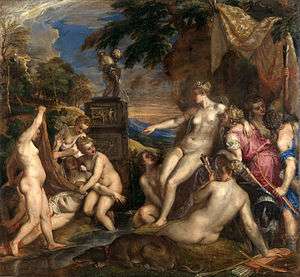 Diana and Callisto
Diana and Callisto
In 2012, the National Gallery in London featured three of the paintings in an exhibition called Metamorphosis: Titian 2012.[18]
References
- ↑ "Danae nach 1554". Kunsthistorisches Museum. Retrieved 5 March 2010.
- ↑ Known versions are held in Naples, London, Madrid, Vienna and St. Petersburg.
- ↑ Amores. 2.19.27-8, ca. 25-16 BC.
- ↑ In some portrayals, notably Rembrandt's, Zeus is shown as a beam of light. See Westermann, 121
- ↑ Cavalcaselle, Giovanni Battista. The Life and Times of Titian: With Some Account of His Family. BiblioBazaar, LLC, 2008. 230. ISBN 0-559-78582-8
- 1 2 Sluijter, 225
- ↑ Northcote, 273
- ↑ Kaminski, 105
- ↑ Kahr, Madlyn Millner. "Virtuous, Voluptuous, Venal Woman". The Art Bulletin, 60/1, March 1978. 43-55
- ↑ Kaminski, 89
- 1 2 Santore, Cathy. "The Renaissance Courtesan's Alter Ego". Zeitschrift für Kunstgeschichte, 54/3, 1991. 412
- ↑ She was not often depicted as a prostitute until the 19th century. See Shell, Marc. Art & Money. Chicago University Press , 1995. 149.
- 1 2 3 "Danae". State Hermitage Museum. Retrieved on 4 March 2010.
- ↑ Ridolfi, Carlo & Bondanella, Julia Conway. The Life of Titian. Pennsylvania State University Press, 1996. 117. ISBN 0-271-01627-2
- ↑ Kaminski, 106
- ↑ Hope, Fletcher & Dunkerton, 132
- ↑ Northcote, 273–274
- ↑ National Gallery, Metamorphosis: Titian 2012
Sources
| Wikimedia Commons has media related to Danae. |
- Hope, Charles & Fletcher, Jennifer & Dunkerton, Jill. Titian. National Gallery London, 2003. ISBN 1-85709-904-4
- Hudson, Mark. Titian: The Last Days. London: Bloomsbury, 2009. ISBN 978-1-4088-0132-1
- Kaminski, Marion. Titian. Ullmann, 2007. ISBN 978-3-8331-3776-1
- Northcote, James. The life of Titian: with anecdotes of the distinguished persons of his time. Volume II. London : H. Colburn and R. Bentley, 1830.
- Sluijter, Jan Eric. Rembrandt and the female nude. Amsterdam University Press, 2006. ISBN 90-5356-837-9
- Westermann, Mariët. Rembrandt. London: Phaidon, 1999. ISBN 0-7148-3857-8
